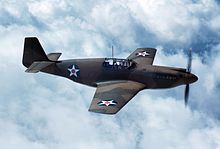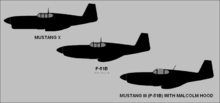- Rolls-Royce Mustang Mk.X
-
Mustang Mk.X Mustang Mk X AM203 in the third configuration tested with a high-speed paint finish applied by Sanderson and Holmes, the coachbuilders in Derby, UK. Role Experimental aircraft Manufacturer Rolls-Royce First flight 13 October 1942 Introduction experimental Primary users Royal Air Force
United States Army Air ForcesNumber built 5 Developed from P-51 Mustang The Mustang Mk.X (as in "Mark.10"; also known as the "Rolls-Royce Mustang") was a British variant of the US North American P-51 Mustang using a Rolls-Royce Merlin engine in an experimental program established by the Rolls-Royce company in 1942.
Contents
Design and development
In April 1942, the Royal Air Force's Air Fighting Development Unit (AFDU) tested the Allison V-1710-engined Mustang at higher altitudes and found it wanting, but their Commanding Officer, Wing Commander Ian Campbell-Orde was so impressed with its maneuverability and low-altitude speed that he invited Ronnie Harker from Rolls-Royce's Flight Test establishment to fly it.
It was quickly evident that performance, although exceptional up to 15,000 ft (4,572 m), was inadequate at higher altitudes. This deficiency was due largely to the single-stage supercharged Allison engine, which lacked power at higher altitudes. Still, the Mustang's advanced aerodynamics showed to advantage, as the Mustang Mk.I (P-51A) was about 30 mph (48 km/h) faster than contemporary Curtiss P-40 fighters using the same Allison powerplant. The Mustang Mk.I was 30 mph (48 km/h) faster than the Spitfire Mk VC at 5,000 ft (1,524 m) and 35 mph (56 km/h) faster at 15,000 ft (4,572 m), despite the latter having a significantly more powerful engine than the Mustang's Allison.[1]
Rolls-Royce engineers rapidly concluded that the Mustang powered by a Merlin 61 would result in a significant improvement in performance and started converting five Mustangs to Merlin power as the "Mustang Mk.X" (i.e., Mk.10) With a minimum of modification to the engine bay, the Merlin engine neatly fitted into the adapted engine formers. A smooth engine cowling with an "chin" radiator was tried out in various configurations. The Merlin 65 series engine was utilized in all the prototypes as it was identical to the Merlin 66 powering the Spitfire Mk IX, allowing for a closer comparison. Due to the speed of the conversions, engines were often swapped from aircraft to aircraft as well as being replaced by newer units.
Testing
The high-altitude performance was a major advance over the Mustang I, with the Mustang X serial AM208 reaching 433 mph (697 km/h) at 22,000 ft (6,506 m) and AL975 tested at an absolute ceiling of 40,600 ft (12,375 m). Air Ministry official, hall Sir W.R. Freeman (Chief Executive at the Ministry of Aircraft Production) lobbied vociferously for Merlin-powered Mustangs, insisting two of the five experimental Mustang Mk Xs be handed over to Carl Spaatz for trials and evaluation by the U.S. 8th Air Force in Britain. After sustained lobbying at the highest level, American production started in early 1943 of a North American-designed Mustang patterned after a P-51 Mustang prototype originally designated the XP-78 that utilized the Packard V-1650-3 Merlin engine replacing the Allison engine.
The pairing of the P-51 airframe and Merlin engine was later designated P-51B or P-51C (B (NA-102) being manufactured at Inglewood, California, and C (NA-103) at a new plant in Dallas, Texas, in operation by summer 1943). The RAF named these models Mustang Mk.III. In performance tests, the P-51B achieved 441 mph (710 km/h) at 25,000 ft (7,620 m) and subsequent extended range with the use of drop tanks enabled the Merlin-powered Mustang version to be introduced as a bomber escort.
Variants
- Mustang Mk.X conversions:
- AG518: Used for engine installation studies, but due to a lack of guns, armour and wireless equipment, it was deemed by Rolls-Royce to be "below" latest production standards and not converted.
- AM121: This aircraft arrived at the Rolls-Royce Flight Test Establishment at Hucknall on 7 June 1942 and was the first to be delivered but the last to be converted. A broader chord fin was installed but the aircraft was not slated for testing at Hucknall and instead was sent to RAF Duxford before being loaned to the 8th Fighter Command USAAF at Bovington along with AL963.
- AL963: First used for performance and handling trials of the Mustang I before conversion on 2 July 1942; its nose contours had a much "sleeker" appearance due to the intercooler radiator being relocated to the main radiator duct. Other changes included a small fin extension and the "blanking" of cowling louvres. This example was able to reach 422 mph (679 km/h) at 22,400 ft (6,828 m). It was sent to the USAAF Air Technical Section at Bovington for evaluation.
- AL975/G: First used for performance and handling trials of the Mustang I before conversion on 2 July 1942; flying for the first time on 13 October 1942. The aircraft was identifiable by a bulged lower engine cowling and was also fitted with a four-blade Spitfire Mk IX propeller. In testing, it achieved a top speed of 425 mph (684 km/h) at 21,000 ft (6,401 m).
- AM203: The third aircraft was fitted with a four-bladed, 11 ft 4 in wooden propeller and achieved 431 mph (694 km/h) at 21,000 ft (6,401 m).
- AM208: The second conversion had the front radiator flap sealed permanently giving a 6-7 mph (10-11 km/h) boost. The same modification was subsequently made to all test aircraft.
Advanced developments
In June 1943, Rolls-Royce proposed to re-engine the Mustang with a Griffon 65, although the resultant "Flying Test Bed" (F.T.B.) would involve a dramatic redesign. Three surplus Mustang I airframes were allotted by the Ministry of Air Production and were dismantled in order to provide the major components for a mid-amidships installation of the more powerful Griffon engine. The project culminated in a mock-up, albeit with a Merlin 61 temporarily installed, serialed as AL960, that was examined by representatives from the Ministry in 1944, but was not given priority status. Further studies involving more powerful engines or turboprops were not given approval and the development contract was cancelled in 1945 with the mock-up being destroyed.[2]
Operators
See also
- Related development
- North American P-51 Mustang
- North American A-36
- North American F-82 Twin Mustang
- Cavalier Mustang
- Piper PA-48 Enforcer
- Titan T-51 Mustang
- Aircraft of comparable role, configuration and era
- Related lists
References
Notes
Bibliography
- Birch, David. Rolls-Royce and the Mustang. Derby, UK: Rolls-Royce Heritage Trust, 1987. ISBN 0-9511710-0-3.
- Delve, Ken. The Mustang Story. London: Cassell & Co., 1999. ISBN 1-85409-259-6.
- Gruenhagen, Robert W. Mustang: The Story of the P-51 Mustang. New York: Arco Publishing Company, Inc., 1969. ISBN 0-668-039124.
External links
Lists relating to aviation General Aircraft (manufacturers) · Aircraft engines (manufacturers) · Airlines (defunct) · Airports · Civil authorities · Museums · Registration prefixes · Rotorcraft (manufacturers) · TimelineMilitary Accidents/incidents Records Categories:- United States fighter aircraft 1940–1949
- British fighter aircraft 1940–1949
Wikimedia Foundation. 2010.




